| dc.description.abstract | Using a mixed methods approach, this article-based thesis investigates some of the implications of web technologies for political participation and for voluntary organizations in Norway. First, in a general theoretical and methodological introduction to the articles, concepts, theories and existing research concerning civil society, network society, political participation, social construction of technology and mixed methods research are discussed. Second, in four individual journal articles, four specific research questions are addressed: Article 1: Diffusion of online political participation. Urban context and social network. This article is based on analyses of survey data from active social network site users in Norway. It is concerned with how our social context, in terms of urbanity and social networks, is related to political participation on the social network site Facebook. It indicates that rather than an urban-rural divide in the diffusion of new political forms on Facebook, other factors – most significantly traits of social networks – seem to be related to political participation on Facebook. Diversity in types of Facebook contacts and in offline discussion partners is positively associated with political activities on Facebook. Article 2: Web Technologies in Practice. The Integration of Web Technologies by Environmental Organizations. In the second article, using a case study approach, I investigate three Norwegian climate and environment protection groups to explore the meanings and implications surrounding web communication. Here, I am investigating the social construction of the web as a medium: how web technologies can shape and be shaped by organizational norms and culture. The article discovers different enactments of practices surrounding web technologies, representing a variation between centralized one-to-many communication and a more decentralized many-to-many communication. Different structures, norms and cultures in organizations shape the implementation of and practices surrounding web technology, and the technology may further reinforce these structures, norms and cultures in organizations. Article 3: Internet communication: Does it strengthen local voluntary organizations? Analyzing survey data from voluntary organizations, article three is concerned with how the structure of communication through the internet is related to organizational change, face-to-face activities and the sustainability and vitality of voluntary organizations. The analyses indicate that the use of e-mail and the web, but not social network sites, is extensive in local voluntary organizations, particularly in larger and younger organizations, in urban organizations, and in organizations with a higher proportion of younger members. The internet is used mostly as an administrative tool and as a one-way channel of information. The use of the internet is positively associated with increased activities and membership in the organizations but is also related to a centralization of organizations. Article 4: Associations online: Barriers for Using Web-based Communication in Voluntary Organizations. Article four asks what barriers might exist for implementing new communication technologies in local voluntary organizations. Analyses of survey data from organizations and data on their web representations indicate that a certain numerical point must be reached in terms of organizational and community size for social network sites to be useful in voluntary organizations. Small organizations in small communities with few active volunteers do not adopt social network sites as much as larger and more complex organizations. Also, if the member base of an organization mostly consists of older members, the financial economy is small, and the organization has a low degree of formalization, it reduces the likelihood of having a social network site profile. With regard to the question in the title of this dissertation “From face-to-face to Facebook?” the four articles point to different implications of web technologies on face-to-face communication in the Norwegian civil society. They show that political participation can take place on Facebook as well as through face-to-face encounters and that although communication through Facebook is not widespread among local voluntary organizations it can supplement face-to-face communication in the running of some organizations. The articles show that general internet use in organizations is positively associated with face-to-face activities in organizations and that face-to-face communication and other traditional forms of communication might be sufficient in the running of some organizations, limiting their use of new communication channels such as Facebook. Summarizing the empirical findings, and in relation to the theoretical discussions in this thesis, I argue that this thesis points to a two-sided story of the implications of web technologies in the Norwegian civil society. On one side, web technologies in the form of web 1.0 with traditional web sites and one-way communication are widespread among local voluntary organizations. A traditional logic of organizing and centralizing information, knowledge, interests and decisive power in a formal organization with defined boundaries seems to be in agreement with the logic of web 1.0. The use of web 1.0 technologies is positively related to signs of organizational growth and vitality as well as to a centralization of organizations. Established voluntary organizations can implement social network sites in their organizational communication, but it seems to be driven by the traditional organizational logic of centralized one-way information dissemination to a defined audience. The other side of the story is the increasingly decentralized many to-many-communication of web 2.0, which favors less constrained individuals connected through social networks mediated by web technology. Accordingly, web 2.0 seems to clash with the logic behind established formal and centrally controlled organizations. This thesis finds traces of a network individualization process in regard to the diffusion of new forms of political participation on Facebook, which seems to be more related to the traits of our social networks both on- and offline than the traits of our place of residence. Also, in newly initiated groups and networks less constrained by institutionalization and structural inertia, the web 2.0 features will more easily be implemented and used for multi-way communication, mobilization and participation in less centralized networks. | en_US |
| dc.relation.haspart | Paper IV: Eimhjellen, I., Wollebæk, D., Strømsnes, K. (2014) Associations online: Barriers for Using Web-based Communication in Voluntary Organizations. Voluntas International Journal of Voluntary and Nonprofit Organizations. 25 (3).730-753. The article is available here: <a href="http://hdl.handle.net/1956/8907" target="blank">http://hdl.handle.net/1956/8907</a> | eng |

